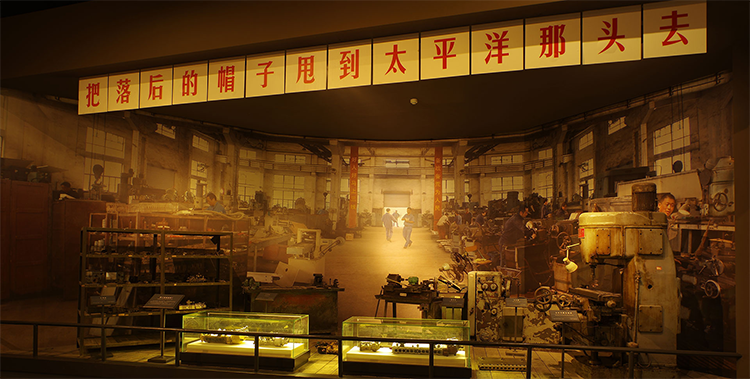Liupanshui Three-Line Construction Museum: A Visitor’s Guide to China’s Industrial Heritage
Nestled in the Wumeng Mountains of Guizhou, a vast ‘steel ship’ rests at the heart of Liupanshui — not a seafaring vessel but China’s only museum dedicated to the Three-Line construction. The museum preserves the industrial legend forged by hundreds of thousands of builders in the 1960s, telling their story through over ten thousand artifacts and immersive scenes that recall the era of ‘preparing for war and hardship for the people.’
1. A Museum, Half an Industrial Epic
As a National 4A Scenic Spot and a national model base for patriotic education, the Liupanshui Three-Line Construction Museum functions as more than a simple collection of relics. Occupying 53,000 square meters, it creates a narrative universe about sacrifice, dedication, and industrial aesthetics. The main building itself is the first exhibit: a stepped steel-frame façade shaped like a ship’s bow symbolizes the builders’ spirit of ‘opening roads through mountains and bridging rivers.’ Its rust-red exterior evokes the weight and texture of the steel industry.
The core displays follow a dual structure of timeline plus themed modules:
– In the ‘Strategic Decision’ gallery, a facsimile of Chairman Mao’s 1964 directive and yellowed military maps reveal the strategic logic behind the Three-Line effort: to dig deep and stockpile widely.
– The ‘Heroes in Action’ reconstructed area recreates the rammed earth houses where workers lived; enamel basins on the walls, kerosene lamps, and bamboo safety helmets whisper the fervor captured by the slogan ‘Good people, good horses, straight to the Three-Line.’
– The museum’s star artifact is a 1972 Soviet-made coal shearer used at Liupanshui’s mines. This three-ton steel giant still bears coal dust between its gears — an industrial fossil of China’s mechanization.
2. Immersive Experiences: Touching Industrial Memory
Unlike traditional history museums, this site emphasizes multisensory interaction:
– In the Industrial Experience Hall visitors can operate a 1:1 replica of an old mine-car rail system to feel the original mechanics of coal transport.
– A panoramic-sound theater continuously screens the documentary ‘Three-Line Stories,’ using first-person accounts from builders’ descendants to evoke heartfelt tales of lives given to the cause.
– The most dramatic feature is the underground-work reconstruction: dimly lit driftways, wax figures of miners with rock drills, and synchronized sound effects that instantly transport visitors to that sweat-drenched era.
Local tip: on the museum’s third floor east wing, the ‘Haoren Haoma’ (Good People, Good Horses) honor wall hides a digital surprise — scan the QR codes to view original worker ID photos and digitized oral histories.

3. Practical Guide: Time-Travel Visitor Tips
Opening hours
Tuesday–Sunday 9:00–17:00 (last admission 16:30) | Closed Mondays (except national holidays)
Tickets
– Permanent exhibits are free | Special exhibitions around 30 RMB
– Foreign visitors can exchange passports directly for tickets | Payment via WeChat Pay and Alipay; international credit cards accepted only at the ticket window
Getting there
– Metro: Take Liupanshui Metro Line 1 to Sanxian Square Station (三线广场站), Exit B, 3-minute walk
– Bus: Routes 12 or 28 to Three-Line Museum stop
– Driving: Underground parking in front of the plaza (5 RMB/hour)
Recommended routes
– Quick visit (1.5 hours): Three-Line Square sculptures → main hall ‘Strategic Decision’ → star coal shearer → underground work scene → Industrial Experience Hall
– In-depth visit (3+ hours): Add the panoramic-sound film, the former Guizhou Coal Administration office ruins, and interactive honor-wall material
4. Nearby Connections: A Day of Industrial Atmosphere
Link the museum with nearby sites to complete a Three-Line cultural day trip:
– Shuicheng Ancient Town (2 km): transformed from worker settlements into a food-focused street; try the local night snack ‘Yelang iced jelly’ and griddle specialties
– Meihua Mountain Cableway (15 km): ride the world’s longest same-route mountain cableway for panoramic views of terrain reshaped by Three-Line projects

Conclusion
While many museums display crowns and jewels, Liupanshui chooses to memorialize oil-stained gloves and faded certificates. The museum may lack glittering artworks, but every rusted bolt tells how, over sixteen years, the Republic’s industrial backbone was built deep in the mountains. For travelers who want to understand the substance of China’s modernization, this ‘time ship’ is unexpectedly moving and revealing.
(Approx. 1580 Chinese-character original)


